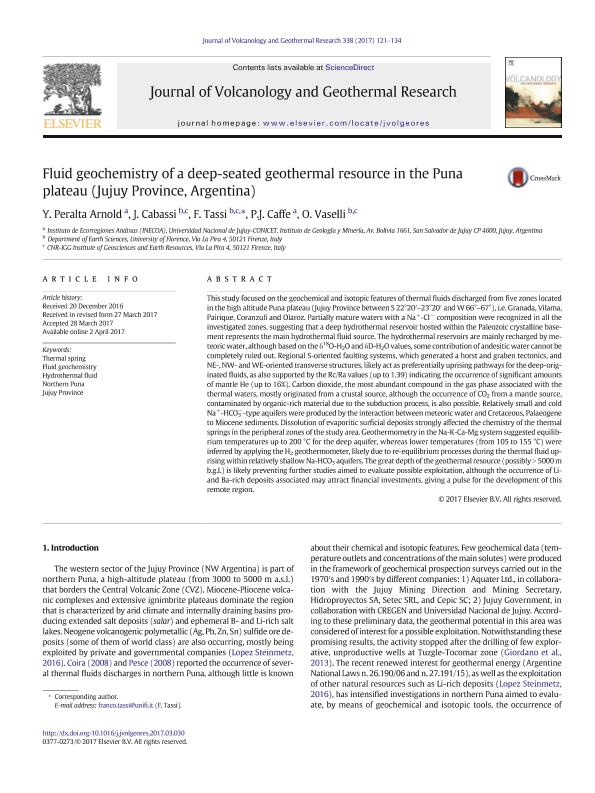Artículo
Fluid geochemistry of a deep-seated geothermal resource in the Puna plateau (Jujuy Province, Argentina)
Fecha de publicación:
02/04/2017
Editorial:
Elsevier Science
Revista:
Journal of Volcanology and Geothermal Research
ISSN:
0377-0273
Idioma:
Inglés
Tipo de recurso:
Artículo publicado
Clasificación temática:
Resumen
his study focused on the geochemical and isotopic features of thermal fluids discharged from five zones located in the high altitude Puna plateau (Jujuy Province between S 22°20′–23°20′ and W 66°–67°), i.e. Granada, Vilama, Pairique, Coranzulí and Olaroz. Partially mature waters with a Na+-Cl− composition were recognized in all the investigated zones, suggesting that a deep hydrothermal reservoir hosted within the Paleozoic crystalline basement represents the main hydrothermal fluid source. The hydrothermal reservoirs are mainly recharged by meteoric water, although based on the δ18O-H2O and δD-H2O values, some contribution of andesitic water cannot be completely ruled out. Regional S-oriented faulting systems, which generated a horst and graben tectonics, and NE-, NW- and WE-oriented transverse structures, likely act as preferentially uprising pathways for the deep-originated fluids, as also supported by the Rc/Ra values (up to 1.39) indicating the occurrence of significant amounts of mantle He (up to 16%). Carbon dioxide, the most abundant compound in the gas phase associated with the thermal waters, mostly originated from a crustal source, although the occurrence of CO2 from a mantle source, contaminated by organic-rich material due to the subduction process, is also possible. Relatively small and cold Na+-HCO3−-type aquifers were produced by the interaction between meteoric water and Cretaceous, Palaeogene to Miocene sediments. Dissolution of evaporitic surficial deposits strongly affected the chemistry of the thermal springs in the peripheral zones of the study area. Geothermometry in the Na-K-Ca-Mg system suggested equilibrium temperatures up to 200 °C for the deep aquifer, whereas lower temperatures (from 105 to 155 °C) were inferred by applying the H2 geothermometer, likely due to re-equilibrium processes during the thermal fluid uprising within relatively shallow Na-HCO3 aquifers. The great depth of the geothermal resource (possibly > 5000 m b.g.l.) is likely preventing further studies aimed to evaluate possible exploitation, although the occurrence of Li- and Ba-rich deposits associated may attract financial investments, giving a pulse for the development of this remote region.
Archivos asociados
Licencia
Identificadores
Colecciones
Articulos(INECOA)
Articulos de INSTITUTO DE ECORREGIONES ANDINAS
Articulos de INSTITUTO DE ECORREGIONES ANDINAS
Citación
Peralta Arnold, Yésica Jael; Cabassi, J; Tassi, Franco; Caffe, Pablo Jorge; Vaselli, O.; Fluid geochemistry of a deep-seated geothermal resource in the Puna plateau (Jujuy Province, Argentina); Elsevier Science; Journal of Volcanology and Geothermal Research; 338; 2-4-2017; 121-134
Compartir
Altmétricas




